七新目标unit3 how do you get to school说课
人教版新目标英语七年级下册《Unit3Howdoyougettoschool》说课稿5

人教版新目标英语七年级下册《Unit 3 How do you get to school》说课稿5一. 教材分析《Unit 3 How do you get to school》是人教版新目标英语七年级下册的一单元,本单元的主题是关于学生上下学的交通方式。
通过本单元的学习,学生可以掌握有关交通方式的基本词汇和句型,并能够用英语进行简单的交流。
教材通过真实的语境和生动的语言,培养了学生运用英语进行日常交流的能力。
二. 学情分析面对七年级的学生,他们已经掌握了一些基本的英语语法和词汇,对于日常的交流已经有了一定的掌握。
但是他们对于交通方式的相关词汇和表达可能还不够熟悉,因此,在教学过程中,我们需要注重引导学生掌握相关词汇和句型,并能够灵活运用。
三. 说教学目标1.知识目标:学生能够掌握关于交通方式的基本词汇,如bus, trn, bike等,并能够正确运用它们进行表达。
学生能够掌握并运用一般现在时描述自己的日常活动。
2.能力目标:学生能够通过听、说、读、写的训练,提高自己的语言运用能力。
学生能够通过pr work, group work等形式,提高自己的合作交流能力。
3.情感目标:学生能够积极参与课堂活动,增强对英语学习的兴趣。
学生能够了解不同的交通方式,增强环保意识。
四. 说教学重难点1.重点:学生能够掌握关于交通方式的基本词汇和句型,并能够正确运用。
学生能够运用一般现在时描述自己的日常活动。
2.难点:学生能够熟练运用一般现在时进行描述,能够正确运用相关词汇和句型进行交流。
五. 说教学方法与手段1.教学方法:采用任务型教学法,通过设定各种任务,引导学生运用英语进行交流。
采用交际法,让学生在真实的语境中学习英语。
2.教学手段:利用多媒体课件,为学生提供丰富的视觉和听觉材料。
利用板书,帮助学生理解和记忆。
六. 说教学过程1.引入:通过提问学生上学的方式,引入本课的主题。
2.呈现:通过展示图片和真实情境,呈现本课的主要词汇和句型。
2023年人教版七年级英语下册Unit 3 How do you get to school(第2课

Unit 3 How do you get to school(第2课时)教案Unit 3How do you get to school?Period 2Content Section A 2d, 2e, Grammar focus, 3a, 3b, 3c教学目标要求1.能够用How询问交通方式,如:How do you get to school? I …2.能够用How long询问时长,如:How long does it take…? It takes …3.能学用How far询问距离,如:How far is it from…to…? It’s about …4.能够掌握本课出现的固定套语,如:It takes about 25 minutes to walk and 10 minutes by bus.5.能够正确区分词组,如:take the bus和by bus等。
6.能认读并能工整书写所学单词:new, every, by, drive, car, live等。
7.在目标语言中能熟练运用一般现在时的一般疑问句及其回答,如:Does Jane walk to school? No, she doesn’t.8.能模仿录音正确朗读和表演教材上的对话并能分角色对目标语进行进一步的表达(会话)。
如:2d的对话,3c的调查等。
1 / 10教学过程活动步骤教与学活动目的及其操作教学资源运用复习时间4 m 1复习已学目标语和导入谈论交通方式的话题Look at the picture. The girl is Mary. How does Mary get to school? (She takes the subway.)2仿照上述对话,组织Pair work复习活动OK. Now look at the pictures. Let’s do pair work, ask and answer the questions.学生双人活动,教师抽查几对学生导入时间2 m 3导入新课话题Look at the picture and now you are Tom, answer my questions.—How do you get to school?—How long does it take to get to school?—How far is it from the school to your home?4引入单元标题教师板书或课件显示:Unit 3 How do you get to school?2 / 102d 时间6 m 5齐读,然后分角色读Let’s read Conversations.6仿照上述对话,组织Pair workNow work in pairs, Student A is Jane, Student B is Tom. Use the information in 2b to make conversations.3 / 107拓展训练活动:哪位同学离校近,哪位离校远1.How do you get to school every day? Do you want to know how your classmates get to school? Whose home is near to school? And whose home is far from school? Please workwith your group and try to give me the answers.学生以小组为单元展开活动,询问彼此上学的途径、耗时及路程并填写右侧表格2.Now report your survey result. Others please write down the result.3.Discuss: How many students go to school by bus? How many go to school by bike? How many walk to school? How many go to school by other means?4 / 102e 时间6 m 8读图,了解对话情景—地点和谈论的话题First, look at the picture and read 2d.Then, answer:T: Who are the girls?S:(Lisa and Jane)T: Where are they?S: Near the school第一步:要求学生集体放声朗读对话,并从中发现学生的生词障碍;第二步:简短讲解、学习生词;9分角色练习对话以提升口语表达水平Role-play the conversation.Ask 1 or 2 pairs to show the conversation.5 / 1010语言探索发现,找出固定套语1.学生自主摘录出对话中新出现的固定套语;2.将自己的结论与周边同学合作对照,互通有无,修改完善;3.课堂师生讨论,确认答案。
七年级下册英语Unit3Howdoyougettoschool教案

Unit 3 How do you get to school?Section A 1 (1a-2d)一、教学目标:1. 语言知识目标:1) 能掌握以下单词:train, bus, subway, ride, bike, sixty, seve nty, eighty, nin ety, hun dred, far, minute,kilometer, n ew, every, every day2) 能掌握以下句型:①一How do you get to school? —I ride my bike.②—How does Mary get to school? —She takes the subway.2. Talk about how to get to places 谈论出行方式)take the bus /subway /train /taxi , ride a bike /walk .3. how引导的特殊疑问句,表示乘坐何种交通工具的方式。
how far, how long弓I导的特殊疑问句。
4. 复习基数词及时间的表示方法。
2•情感态度价值观目标:让学生感受到他们学习英语是为了在现实生活中进行交流,而不单纯是为了英语课和应付考试而学习,了解东西方国家出行方式的不同,以及不同的交通规则教育学生注意交通安全,加深对交通知识的了解。
倡导自觉遵守交通法规及礼貌,构建和谐的人际关系。
了解交通的发展,培养创新精神。
二、教学重难点1. 教学重点:1) how /how far /how long引导的特殊疑问句.2) 乘坐交通工具的表示方法.3) It takes / sb. some time to do sth..2. 教学难点:—How do you get to school? —I take the …/ride …/ walk …—How does Mary get to school? —She takes the subway.——How long does it take? ——It takes forty minu tes.—It's …kilometers.—How far is it from …to…三、教学过程I . Warming-up and Lead in学生和老师进行简单的问候Ss: Good morning, teacher.T: Good morning, classT: Look at the picture. What can you see? Do you like your school? I usually get to school by bike, but sometimes on foot. How do you get to school?Ss按实际情况作答S1: I ride my bike.S2: I go by bus.S3: ............T: Very good. You ' re clever. Let ' s learn Unit 4之后板书:A.“ Unit 4 How do you get to school?”n. Presentation1. T: If you are here, but your school is in Shan ghai. How do you get to school?Ss: I take the bus /pla ne/ boat / ship / car / taxiI ride a bike / motorbikeT: Do you know any other way?2. Teacher shows pictures on the big scree归纳出行方式和常用短语.Ask some questi ons about how you get to •?(让学生积极主动的思考想象总结,多媒体增加趣味性,加强直观性,效果事半功倍)3. Show a picture about Part 1, on the scree n.Point at girls or boys in the picture.Ask stude nts to an swer and write in the bla nks.S1: How does he / she go to school?S2: He / She .............川.1aT: Look at the picture on your book. Match the words with the picture.(学生们完成1a的学习任务,然后校对答案)IV. Listening1. Make sure the Ss know what to do. Give them an example orally if possible.2. Read the n ames in the box.3. Play the tape and check the an swers.V.Pair workAsk two stude nts to read the dialogue in the speech bubbles to the class. Then ask stude nts to work in pairs. Ask and an swer how stude nts get to school in the picture. Fin ally ask some pairs of stude nts to prese nt their conv ersatio ns to the class.W. Listening1. Revise the numbers, first, zero~nine, next, ten~nineteen, then, twenty, thirty, forty …fin ally,twen ty-one, twen ty-two …Teach the new word "hun dred".2. Play the tape for the stude nts to finish 2a. Then play aga in and check the an swers VD. PresentationShow a picture on the TV and expla in these are your home and school.Teach: home----school How long 10 minutes How far two kilometersThen make up a dialogue to practice.A: How do you get to school?B: I usually take the bus.A: How far is it from your home to school?B: It's about two kilometers.A: How long does it take?B: It takes 30 minu tes by busVffl. Listening1. Tell Ss the follow ing recordi ng is about how Tom and Jane go to school.2. First, liste n to the recordi ng fill in the first colu mn.3. Then, play the recording for the Ss again. Ss listen and complete the rest of the chart.4. Check the an swers.IX. Role-play1. Read the dialogue and find the an swer to these questi ons:①How does Jane get to school?②How far is it from home to school?③How long does it take to get to school from her home?2. Ss read the con versati ons and the n find the an swers to the questi ons.3. Check the an swers with the class.4. Play the record ing for the Ss to liste n and complete.Lisa: Hey, Jan e. Is this your new bike?Jane: Yes. I ____ it to school every day. How do you ____________ ?Lisa: I usually ___________ .Jane: _______ is it from your home to school?Lisa: I ' m not sure … about ______ minutes. ________ does it take you to get to school? Jane: About 15 minutes _______ . It ' s good exercise.Lisa: Yeah. Well, _____________ at school.Jane: You, too.5. Ss read the con versati on the n role-play the conv ersati on.6. Let some pairs act out the conv ersati on.nguage points1. take the subway 乘坐地铁乘坐某种交通工具去某地take + the/a +交通工具+ to +地点=get/go to + 某地+ by + 交通工具e.g. He ofte n takes the subway to work.=He goes to work by subway.注意:当home, here, there作地点时,不加to。
人教版英语七年级下册Unit3howdoyougettoschool单元整体说课稿
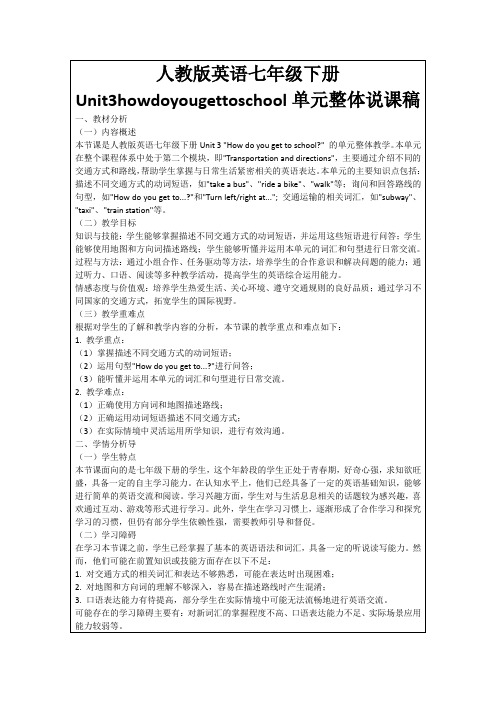
知识与技能:学生能够掌握描述不同交通方式的动词短语,并运用这些短语进行问答;学生能够使用地图和方向词描述路线;学生能够听懂并运用本单元的词汇和句型进行日常交流。
过程与方法:通过小组合作、任务驱动等方法,培养学生的合作意识和解决问题的能力;通过听力、口语、阅读等多种教学活动,提高学生的英语综合运用能力。
(二)学习障碍
在学习本节课之前,学生已经掌握了基本的英语语法和词汇,具备一定的听说读写能力。然而,他们可能在前置知识或技能方面存在以下不足:
1.对交通方式的相关词汇和表达不够熟悉,可能在表达时出现困难;
2.对地图和方向词的理解不够深入,容易在描述路线时产生混淆;
3.口语表达能力有待提高,部分学生在实际情境中可能无法流畅地进行英语交流。
2.角色扮演:学生模拟真实场景,扮演问路人和指路人,进行对话练习;
3.课堂游戏:设计“Transportation Matching”游戏,让学生在游戏中巩固新学的词汇;
4.口语练习:组织学生进行“Ask and Answer”活动,两人一组,互相询问对方的交通方式。
(四)总结反馈
在总结反馈阶段,我将采取以下方式引导学生自我评价,并提供有效的反馈和建议:
1.利用PPT展示一组与交通方式相关的图片,如公交车、自行车、地铁等,让学生猜测并说出这些交通方式的英文表达;
2.播放一段关于不同交通方式的短视频,引导学生关注并思考:“How do people get to school in different countries?”;
3.教师提出问题:“How do you get to school?”,邀请几名学生回答,借此引出本节课的主题。
情感态度与价值观:培养学生热爱生活、关心环境、遵守交通规则的良好品质;通过学习不同国家的交通方式,拓宽学生的国际视野。
七年级下册英语Unit-3-How-do-you-get-to-school-教案

实用文档七年级下册英语Unit 3 How do you getto school 教案和介绍后,老师可以通过展示一些图片或视频,引导学生谈论不同的出行方式,如乘坐公交车、地铁、骑自行车、步行等。
XXX1.首先,老师可以通过展示图片或视频,教授新单词和短语,如train、bus、subway、ride、bike、sixty、XXX、eighty、y、hundred、far、minute、kilometer、new、every、every day 等。
2.然后,老师可以模拟对话,让学生研究如何用英语谈论出行方式。
例如,老师可以问学生“How do you get to school?”,学生可以回答“I ride my bike”,或者老师可以问“How does Mary get to school?”,学生可以回答“She takes the subway”。
3.接下来,老师可以教授特殊疑问句,如“How far is it from…to…”和“How long does it take?”,并且教授如何回答这些问题。
例如,当学生被问到“How far is it from your home to school?”时,学生可以回答“It's 5 kilometers”,或者当学生被问实用文档到“How long does it take to get to school?”时,学生可以回答“It takes 40 minutes”。
Ⅲ。
Practice1.老师可以让学生进行小组讨论,讨论在不同情况下应该选择哪种出行方式,并且给出理由。
2.老师可以让学生进行角色扮演,模拟在不同场景下的出行方式和对话。
3.老师可以让学生完成一些练,如填空、选择题等,以检验他们对所学知识的掌握程度。
XXX1.老师可以引导学生了解不同国家的出行方式和交通规则,让学生了解和尊重不同文化和惯。
2.老师可以教授一些有关交通安全和礼仪的知识,让学生养成良好的交通惯和安全意识。
新目标Unit3Howdoyougettoschool教案

Unit 3 How do you get to school?Period 1 Section A 1a — 1c【学习目标】【学习重点】:1、谈论如何到达某地;学会用how 来问路;2、熟记本课单词和短语。
【体验学习】:I、预习交流1.根据单元标题和图片等,预测新课内容;2.根据音标拼读单词并牢记;3.自学课文,勾画出重点和疑惑。
II、翻译1.到校________________2.坐火车___________________3.坐公汽_______________4.乘地铁___________________5.骑单车________________6. 步行_____________________【课堂导学】:学习任务一::完成活动1a1.要求学生尽可能的说出表示交通工具的词汇2.学习并记住1a中的新单词和短语3.将单词与图画匹配起来4.对话练习------How do you get to school?------I ride my bike to school5. 自编对话,并展示学习任务二:完成1b部分。
1.听录音, 完成活动1b2.听录音, 核对答案3.听录音,跟读并复述对话内容学习任务三:完成1c.1、熟读1a中的对话, 理解并复述.2、两人一组做对话, 谈论1b中人物及自己和同伴的上学方式.------How does Mary get to school?------She takes the subway,学习任务四:总结归纳, 小结乘坐某种交通工具的方式take the +交通工具用来表示“乘……”相当于by +交通工具如:I usually take a bus to work. = I usually go to work _____ _____.take the train to school = go to school by traintake the taxi to the airport =________________w alk to = go to…on foot ride the bike = by bike知识点总结1. 询问交通方式的句型How do/does -------get to ---?回答时可用动词短语(做谓语):take the bus /train /subway /plane /ship to+地点ride my bike /the horse to+地点walk to +地点还可以用介词短语(做状语):by bus /train /subway /plane /bikeon foot /on the bus /on the train /on her bikein his car2. 各种交通工具:(take ,ride , drive ,walk) (by)car, truck, motorbike, bike/ bicycle, subway, taxi, train, bus, plane, school-bus, ship, boat.【练习检测】:I、选择题1. ------_________----- By bus.A. Why does he go to work?B. How does he go to work?C. When does she go to work?2. ----- How do you go to school?----- I ______.A. take busB. take the busC. by the bus3. She usually gets to school on her bike. But she sometimes ______.A. walkingB. walkC. walks4.I usually go to school ___ bike, but sometimes I go to school ___foot.A. with, onB. on, byC. by, onII、句型转换1、He takes a bus to school .(同义句)He gets to school ________ _________ .2、I get to work by boat . (划线提问)________ _________ you get to work ?Ⅲ、用所给词的适当形式填空1. How ________he _______to school? (get)2. Liu Pei ___________the train to school. (not take)3. He ____________ (ride) his bike to work every day.IV、完成单词1. I usually go to school by bus but s ________on foot.2. Liu Mei always rides her bike to school and she never t_______ a bus.3. I hardly ever walk to work. What a________ you?4. It t______ them one and a half hours to do their homework every day.Unit 3 How do you get to school?Period 2 Section A 2a— 2e【学习目标】【学习重点】:1、学习单词和短语sixty ,seventy, eighty, ninety, hundred, minute , kilometer,new, every day, by bike.2、句型:How long does it take from...to...? How far is it from...to...?3、学习how对交通方式提问的特殊疑问句。
英语七年级上册Unit3_SectionA说课稿

新目标英语七年级下册Unit3 SectionA说课稿尊敬的各位老师:你们好!今天我说课的题目是新目标英语七年级下册第三单元Unit3 how do you get to school? 中的SectionA部分,整个说课我将分成五个部分进行:即教材分析、学情分析、教法学法、教学过程及板书设计。
第一板块:教材分析(一)、说教材《新目标英语》教材的语言教育理念是:知识用于行动,强调“语言应用”,培养“创新实践能力”,发展“学习策略”。
它采用任务型语言教学模式。
教材中每单元都设计一个或几个与该单元话题有关的任务,让学生在完成任务的过程中,使用英语获取信息,用英语进行交流,培养运用英语解决实际问题的能力。
本课是新目标英语七年级下册第三单元第二课时,教材以How do you get to school?.为中心话题,围绕着谈论学生们上学的方式,及其他人到达某地的方式,融入了知识重点,学会使用交通工具(二)、教学目标1.知识目标:a)学习单词:by bike, live, car, drive, by等b)学习并掌握句型:How do you get to school? I ride my bike.How does she get to school? She usually takes the bus.How long does it take to get to school? It takes about 15 minutesHow fa is it from your home to school? It’s only about two kilometers.2.能力目标:通过介绍自己的上学方式,学会用英语熟练表达到某地所使用的交通工具。
3.情感目标:让学生们能感受到社会的变化,感受到新时代交通的便利,和对精彩世界的向往。
(三)、教学重难点1. 重点;学习重点单词,句型和语法点:2. 难点:How long 和How far 的使用第二板块:学情分析七年级的学生正处于青春期发育期,他们有较高的求知欲和表现欲,希望自己的表现能得到同学和老师的认可。
人教版七年级下册unit3-How-do-you-get-to-school-单元教案
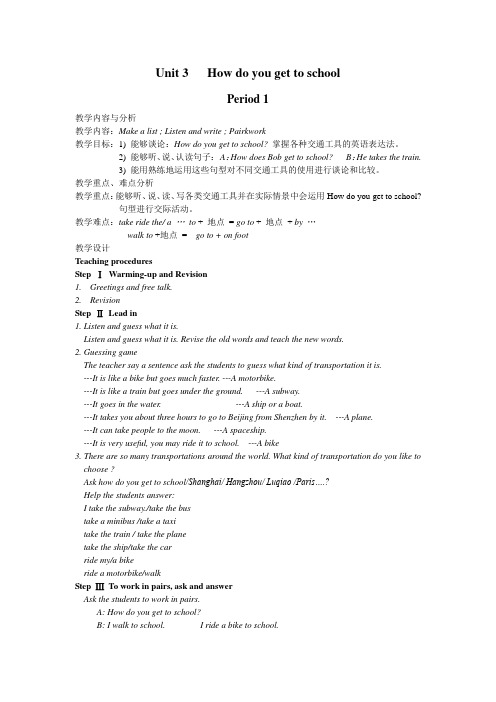
Unit 3 How do you get to schoolPeriod 1教学内容与分析教学内容:Make a list ; Listen and write ; Pairkwork教学目标:1) 能够谈论:How do you get to school? 掌握各种交通工具的英语表达法。
2) 能够听、说、认读句子:A:How does Bob get to school? B:He takes the train.3) 能用熟练地运用这些句型对不同交通工具的使用进行谈论和比较。
教学重点、难点分析教学重点:能够听、说、读、写各类交通工具并在实际情景中会运用How do you get to school?句型进行交际活动。
教学难点:take ride the/ a …to + 地点= go to + 地点+ by…walk to +地点= go to + on foot教学设计Teaching proceduresStep ⅠWarming-up and Revision1.Greetings and free talk.2.RevisionStep ⅡLead in1. Listen and guess what it is.Listen and guess what it is. Revise the old words and teach the new words.2. Guessing gameThe teacher say a sentence ask the students to guess what kind of transportation it is.---It is like a bike but goes much faster. ---A motorbike.---It is like a train but goes under the ground. ---A subway.---It goes in the water. ---A ship or a boat.---It takes you about three hours to go to Beijing from Shenzhen by it. ---A plane.---It can take people to the moon. ---A spaceship.---It is very useful, you may ride it to school. ---A bike3. There are so many transportations around the world. What kind of transportation do you like to choose ?Ask how do you get to school/Shanghai/ Hangzhou/ Luqiao /Paris….?Help the students answer:I take the subway./take the bustake a minibus /take a taxitake the train / take the planetake the ship/take the carride my/a bikeride a motorbike/walkStep ⅢTo work in pairs, ask and answerAsk the students to work in pairs.A: How do you get to school?B: I walk to school. I ride a bike to school.I take a bus to school. I take a car to school.I take the subway to school. I take the train to school.Step ⅣPresentation1. First ask two students to ask and answer in pair.Then ask the other students “how does he/she get to school?”He/She takes the subway. /……rides his/her bike……walks.Step ⅤGroup workAsk the students to do group work.A: How do you get to school?B: I take the bus. / ride my bike/ bicycle./ walk.C: How does he /she get to school?He/She takes the bus/… rides his/her bike/bicyc le ./ walks.Step ⅥWork on 1a and 1b.1. To do Section A 1a look at the picture and write down the way of transportation.2. To listen to the tape and finish1b.Step ⅦPresentationAsk “h ow does Bob get to school?’ Help them answer he takes the train.Then ask “how does Paul get to school?” "He walks."Say Paul usually walks to school. He goes to school on foot.Show some pictures to students. Ask them to say like this.My father rides a bike to work every day. =My father goes to work by bike every day. Step ⅧTo work in pairs, ask and answerShow some pictures to the students then ask then to work in pairs.A: How do you get to......? B: I take/ride/walk......I get to school...by.../on...Step ⅨSummaryTake/ride the/a ...to+地点=go to +地点+by....Walk to+地点=go to +on foote.g. He often takes the subway to work.=He often goes to work by subway.注意:当home, here, there 作地点时to 不要。
七年级英语下册Unit3Howdoyougettoschool课件人教新目标

Section B & Self Check
1
2
3
4
1.For many students,it is easy to get to
school.(教材P17)对许多学生来说,到达学校是容
易的。
[解读] It’s+adj.+to do sth.句式结构中,it是形
式主语,后面的不定式 (短语) to do sth.是真正的主
—Can you come to my party next week? ——你下星期能来参加我的聚会吗? —I’m afraid not.——恐怕我不能来。
1
2
3
4
1
2
3
4
4.Can their dream come true?(教材P17)他们 的梦想能够实现吗?
[解读1] dream 是名词或动词,意思为“梦想;睡梦; 做梦”,构成的短语是dream of/about,意思为 “梦想, 幻想,向往”,of/about 是介词,后接名词或动词-ing 形式。
My dream is to be a teacher. 我的梦想是当一名教师。
He dreams of becoming an actor.
1
2
3
4
1
2
3
4
[解读2] come true 意思为“实现,成为现实”,主语通 常是表示梦想、愿望等的名词。
His dream came true at last. 他的梦想最终实现了。
His wish to become a doctor will come true. 他想当医生的愿望将会实现的。
1
2
3
人教版新目标英语七年级下册《Unit3Howdoyougettoschool》说课稿2

人教版新目标英语七年级下册《Unit 3 How do you get to school》说课稿2一. 教材分析《Unit 3 How do you get to school》是人教版新目标英语七年级下册的一篇课文,主要介绍了学生上下学的交通方式。
本节课文内容贴近学生生活,易于激发学生的学习兴趣。
通过学习本节课文,学生能够掌握描述交通方式的词汇和句型,并能够运用所学知识进行实际交流。
二. 学情分析七年级的学生已经具备了一定的英语基础,对于日常生活中常见的交通方式有所了解。
但是,学生在语言表达方面还存在一定的困难,需要通过本节课的学习,进一步巩固和提高。
此外,学生对于英语学习的兴趣和积极性也需要通过本节课的教学活动来进一步激发。
三. 说教学目标1.知识目标:学生能够掌握描述交通方式的词汇和句型,如“How doyou get to school?”“I get to school by bus.”等。
2.能力目标:学生能够运用所学知识进行实际交流,能够用英语询问并描述他人的交通方式。
3.情感目标:通过本节课的学习,学生能够增强对英语学习的兴趣和自信心,提高学习积极性。
四. 说教学重难点1.重点:学生能够掌握描述交通方式的词汇和句型。
2.难点:学生能够运用所学知识进行实际交流,能够用英语询问并描述他人的交通方式。
五. 说教学方法与手段本节课采用任务型教学法,通过各种教学活动,让学生在实践中学习英语,提高语言运用能力。
同时,利用多媒体教学手段,如图片、视频等,辅助教学,增加课堂趣味性。
六. 说教学过程1.导入:教师通过展示各种交通工具的图片,引导学生谈论交通工具,为新课学习做好铺垫。
2.新课呈现:教师展示课文图片,引导学生观察并回答问题,如“Howdo you get to school?”“I get to school by bus.”等。
3.课文学习:教师带领学生朗读课文,讲解生词和句型,让学生充分理解课文内容。
七年级英语下册Unit 3 How do you get to school period 1说课稿

七年级英语下册Unit 3 How do you get to school period 1说课稿人教新目标版一. 教材分析《人教新目标版七年级英语下册Unit 3 How do you get to school period 1》这一课的主要内容是让学生学会描述自己和他人的上学交通方式。
通过本节课的学习,学生能够掌握相关词汇和句型,如bus, subway, car, ride a bike, walk等,以及询问和回答上学交通方式的句子结构“How do you get to school? I get to school by…”。
二. 学情分析七年级的学生已经具备了一定的英语基础,能听懂简单的英语指令,并能够用英语进行简单的自我介绍。
但部分学生对描述日常生活中的事务还有一定的困难,需要教师的引导和鼓励。
此外,学生的学习兴趣和积极性对英语学习的效果有很大影响,因此在教学过程中,教师需要注重激发学生的学习兴趣。
三. 说教学目标1.知识目标:学生能够掌握描述上学交通方式的词汇和句型,如bus,subway, car, ride a bike, walk等,以及句子结构“How do you get to school? Iget to school by…”。
2.能力目标:学生能够在真实情境中运用所学知识进行交流,如询问和回答上学交通方式。
3.情感目标:通过本节课的学习,学生能够培养对英语学习的兴趣,增强自信心。
四. 说教学重难点1.重点:学生能够掌握描述上学交通方式的词汇和句型,以及句子结构“How do you get to school? I get to school by…”。
2.难点:学生能够在实际情境中灵活运用所学知识进行交流。
五. 说教学方法与手段1.教学方法:采用任务型教学法,情境教学法和交际教学法,让学生在实际情境中学习、练习和运用英语。
2.教学手段:利用多媒体课件、图片、道具等辅助教学,提高学生的学习兴趣和积极性。
初中英语_Unit3How do you get to school教学设计学情分析教材分析课后反思
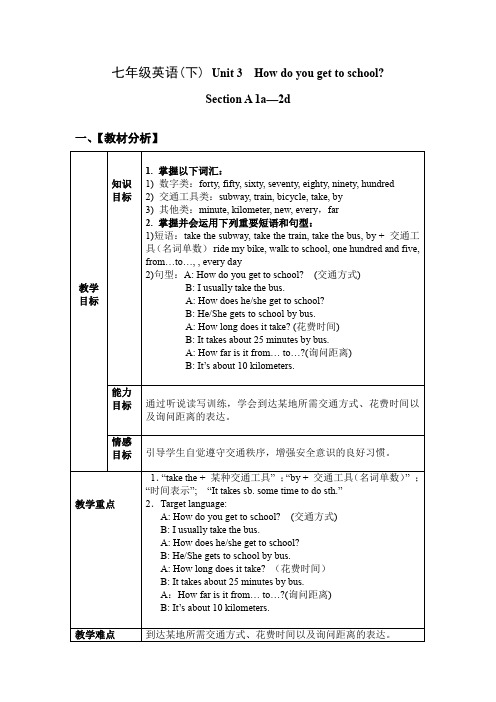
七年级英语(下)Unit 3 How do you get to school?Section A 1a—2d一、【教材分析】三、【板书设计】学情分析:我校的学生大都是来自农村,有一部分学生不是很喜欢上英语课,学习兴趣不是很高,个别学生甚至有厌恶感,同时,有些学生还是为学习而学习,谈不上兴趣问题;另一方面,学生有一定的分化,但也不是全部都差,没基础。
两极分化很大又占了很大的比例也不忍心放弃他们,只能一遍又一遍的重复和练习,而此时那些已经具有大量英语基础知识的学生面对这样的同学和老师的教学,一开始或许还有一种自豪感,但很快便会十分无聊而影响课堂。
现阶段我们现在除了要分析学生的学习状况外,还需了解他们的学习习惯,包括上课听讲、记笔记、做作业以及复习等等。
所以,在教学开始之前如将学习者的起点定得太高,会脱离学习者的实际水平,就会降低教学效果,使学习者在高难度的学习内容面前望而却步;如将学习者的起点定得太低,也脱离学习者的实际水平,会造成时间和精力的浪费,使学习者在低水平的内容上做无效的劳动,长此以往,就会降低学习者的学习兴趣。
因此,比较准确的确定学习者的起点能力,可在一定程度上提高教学效率,收到良好的教学效果。
所以我们要充分认识学生,确定教学思路。
现在学生的学习渠道越来越宽了,他们在学习新知识前,已经有了相当丰富的生活经验和实践积累。
关键在于我们教师如何去充分估计和了解学生的这些已有积累作为学生的学习起点,促进学生的有效学习。
所以针对以上情况,采取以下措施:1 .及时帮助,以防为主教学应面向全体同学,争取做到人人基本达标。
在教学过程中学生学习出现差距是不可避免的。
一旦出现,就应该及时找学生谈,分析他们掉队的原因,课下及时找她们谈话,了解她们的内心想法。
同时给予学习方法的指导,耐心帮助他们补习功课。
对于这些有可能掉队的学生,及早指出,说明掉队的严重后果,做到防患于未然。
2、讲究教法,实施分层教学由于学生的素质不可能一致,有的接受能力强,思维敏捷,动作迅速,有的相反。
全英文说课稿unit3-how-do-you-get-to-school

How do you get to school?Good morning,dear judges. I am No. X , Now I’m going to talk about my teaching planning of section A from Unit 3 “How do you get to school?” Book 2, Grade 7. My presentation consists of five parts. They are Teaching material analysis, Teaching guideline, Teaching aims and demands, Teaching methods, Teaching procedures. Now, let me get to part1.Part 1 Teaching material analysisSection A Unit 3 is around the topic“How do you get to school?” In this section, the students are going to learn different kinds of transportations(train, bus subway, bike), and conversations, such as, how long does it take to go somewhere and how far between two places. This topic is related to our daily life. I’ll set up a free and relaxing atmosphere to a rouse the students’ interest and improve their listening, speaking, reading and writing skills.Part 2 Teaching guidelineAs we all know people learn a language in order to communicate. As a language teacher, I realize that it’s important to develop the students’communication competence . It seems to me there are three points to improve it. First, lay special emphasis on developing listening/speaking/reading/writing skills. Second, let the students understand the daily conversation better. Third, practice the spoken English more to improve the ability to communicate freely.Part 3 Teaching aims and demands1. knowledge objects1). to study the topic about transportation and how to get places2). to study the new words: take the train/ subway, go by bike/bus, ride a bike, drive a car, between…and…,and so on.3). to let the students know how to use the sentences “How do you get to school?/How long does it take…?/How far is it from…”2.Ability objects1).to develop the student s’ abilities of listening, speak ing, reading and writing .2).to develop the student s’ abilities of communication by learning the usefulstructures.3.Moral objects1). to enable the students to express themselves freely.4.Teaching key points and difficultiesEnable the students to make conversations about transportation. Develop their communicative ability. It’s hard for the students to distinguish the words“by”.”take”, ”ride”. “drive” when it’s come to different transportations.Part 4 Teaching methodsIt’s generally known that the aims of learning English in the junior middle school is to improve the students’ listening, speaking, reading and writing abilities. There are different teaching methods, such as five-step teaching method, audio-visual teaching method, task-based language teaching, In this lesson I’ll mainly use “Task-based” teaching method. That is” learning by doing”“doing things with the language”. I’ll give the students some tasks and arrange some activities: watching pictures, talking, role-play the conversation, pair/group work.Part 5 Teaching procedures.It is made up of 5 steps. They are warming up, presentation, group work, practice, summary and homework.Now let’s go to the first step:Step1. warming upThe purpose is to arouse the students’ interest of study. At the beginning of the class, we will greet each other, then a free talk, and move to the next step .Step2. Presentation1) Let the students look at some pictures. Ask: what can you see? What is the girl doing? How does she get to school? Lead the students to answer: she rides a bike to school.2)Learning new words and sentences. First, I’ll show the new words ( train, bus, bike, subway), then enable the students to pronounce the new words correctly, next I’ll lead the students to read these new words together. After learning the news words, I’ll lead in the new sentences ”How do you ge t to school” /How long does it take…?/How far is it from…”, then show the students how to use these questions to make conversations with each other.Step3. Group workLead the students to discuss the different transportations(train/bus/subway).Step4. Practice1) Making a dialogue(role-play). After learning new words and sentences, I’ll give the students a task to make dialogues, as follows:A:How do you get to school?B:I get to school by bus.A:How far is it from your home to school?B:It’s about 10 kilometers.A:How long does it take?B:It takes 20 minutes by bus.2) Listening practice. Ask the students to finish 1b, listen and write the numbers next to the correct person in the picture.Step5. Summary and homework1) Ask the students to sum up what they’ve learnt on this lesson2).Ask the students to do a survey and write it down in the chart on page15. Ladies and gentlemen, that’s all about my teaching planning, thanks for your time, have a good day!。
新课标人教版七年级英语下unit3评课与说课
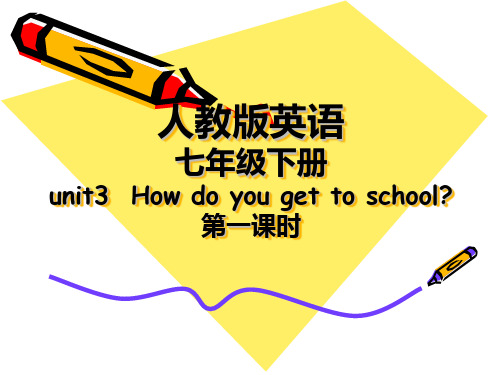
乘坐公车
6. walks = on foot
走路、步行
7. get to
到达
How do you get to school? ride a bike (go by bike) take the bus (go by bus) take the train (go by train) take the car (go by car)
B: First, I take a bus to the train station. Then, I take the train.
You A: How do you get to school?
B: First, I ride my bike to the subway station. Then I take the subway.
二 教材分析
第三单元第一课时是以讨论学生以 何种方式上学为中心话题,这是日 常口语交流中非常实用和重要的内 容。根据新课标对学生交际能力的 培养要求,我将本课设计为以PPT 展示为主的一堂英语导入课。
三教学目标
为了不仅要完成正常的教 学任务,还要有效地培养学 生的口语交际能力和实践能 力,确定如下教学目标:
Phrases
1. ride a bike = by bike
骑自行车
2. take the subway = by subway 乘坐地铁
3. take the train = by train 乘坐火车
4. take a plane = by plane
乘坐飞机
5. take the bus = by bus
在人际交往中学会尊重、学会沟通,更
学会交换不同的看法以增进情意。
四 教学方法
英语七年级下人教版新课标Unit_3_How_do_you_get_to_school SectionA 1a-1c教学设计新部编版
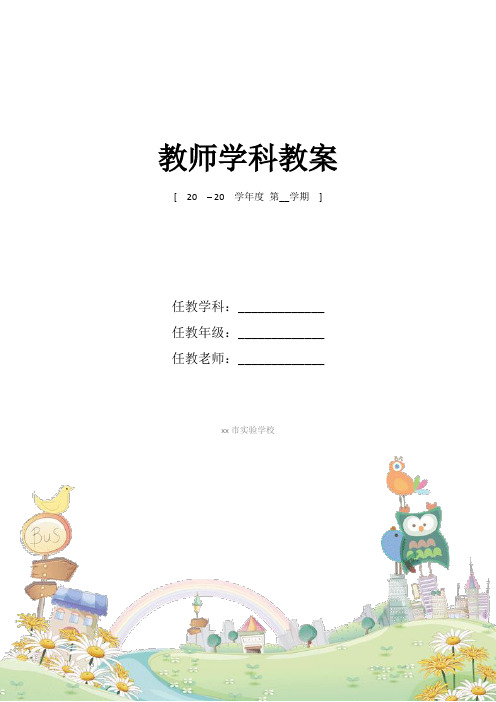
教师学科教案[ 20 – 20 学年度第__学期]任教学科:_____________任教年级:_____________任教老师:_____________xx市实验学校英语七年级下人教版新课标Unit 3 How do you get to school Section A 1a-1c教学设计熨斗中学阮班玉一、概述本单元以“交通工具”为中心话题,围绕谈论“How do you get to school?”而展开教学及运用How long/How far 询问去某地的时间和距离,而Section A (1a-1主要是学习交通工具的单词和运用how引导的特殊疑问句,询问到达目的地的,这一话题贴近学生们的日常生活,它继第三单元谈论“假日计划”后安排这样一个话题,符合学生的认知结构和年龄特征,它将为本单元后面的课时做好铺垫,也为学生口语交际打下基础。
本课是本单元的第一课时。
本单元认识掌握交通工具,然后学习短语take the subway, take the train, ride a bike, walk等,最后学习句型How do you get to school? I take the bus. 在本节课中学生要学习练习含有第一,二人称和第三人称单数,How 引导的特殊疑问句。
How doe Mary get to school? She takes the subway.二、教学目标分析:1. 知识与技能:1) 能掌握以下单词:bus, train, subway, taxi, walk, pane, ride, bike.2) 能掌握以下短语:take the bus, take the subway, take the train, take the taxi, take the plane, take the car,drive the car, ride the bike, walk.3) 能掌握以下句型:①—How do you get to school?ride my biketake the busI take the subway to school.take the taxitake the carwalk②—How does Mary get to school?rides my biketakes the busShe takes the subway to school.takes the taxitakes the carwalks4)学会将课内外习得的生词和习惯用语、谈论交通工具等综合运用。
Unit3Howdoyougettoschool说课稿新
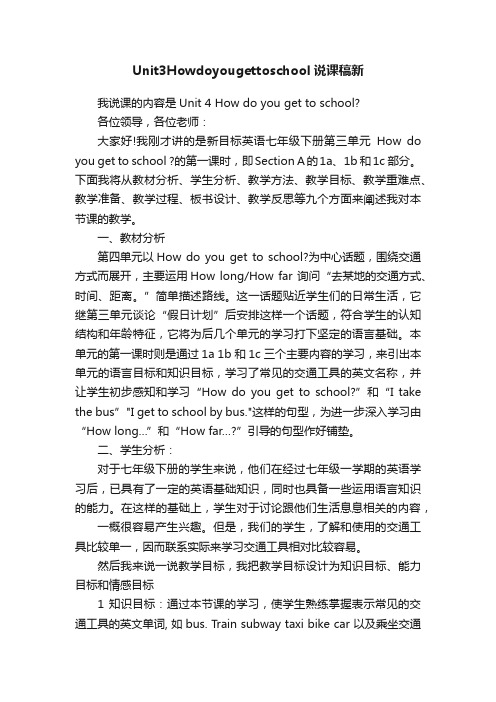
Unit3Howdoyougettoschool说课稿新我说课的内容是Unit 4 How do you get to school?各位领导,各位老师:大家好!我刚才讲的是新目标英语七年级下册第三单元How do you get to school ?的第一课时,即Section A的1a、1b 和1c 部分。
下面我将从教材分析、学生分析、教学方法、教学目标、教学重难点、教学准备、教学过程、板书设计、教学反思等九个方面来阐述我对本节课的教学。
一、教材分析第四单元以How do you get to school?为中心话题,围绕交通方式而展开,主要运用How long/How far 询问“去某地的交通方式、时间、距离。
”简单描述路线。
这一话题贴近学生们的日常生活,它继第三单元谈论“假日计划”后安排这样一个话题,符合学生的认知结构和年龄特征,它将为后几个单元的学习打下坚定的语言基础。
本单元的第一课时则是通过1a 1b 和1c三个主要内容的学习,来引出本单元的语言目标和知识目标,学习了常见的交通工具的英文名称,并让学生初步感知和学习“How do you get to school?”和“I take the bus”"I get to school by bus."这样的句型,为进一步深入学习由“How long…”和“How far…?”引导的句型作好铺垫。
二、学生分析:对于七年级下册的学生来说,他们在经过七年级一学期的英语学习后,已具有了一定的英语基础知识,同时也具备一些运用语言知识的能力。
在这样的基础上,学生对于讨论跟他们生活息息相关的内容,一概很容易产生兴趣。
但是,我们的学生,了解和使用的交通工具比较单一,因而联系实际来学习交通工具相对比较容易。
然后我来说一说教学目标,我把教学目标设计为知识目标、能力目标和情感目标1 知识目标:通过本节课的学习,使学生熟练掌握表示常见的交通工具的英文单词, 如bus. Train subway taxi bike car 以及乘坐交通工具的英文表达法如take the bus by bus on foot2 语言目标:1)、引导学生学会How引导的特殊疑问句,以及如何熟练运用动词“take”和介词“by”,来表达乘坐交通工具的方法。
- 1、下载文档前请自行甄别文档内容的完整性,平台不提供额外的编辑、内容补充、找答案等附加服务。
- 2、"仅部分预览"的文档,不可在线预览部分如存在完整性等问题,可反馈申请退款(可完整预览的文档不适用该条件!)。
- 3、如文档侵犯您的权益,请联系客服反馈,我们会尽快为您处理(人工客服工作时间:9:00-18:30)。
= Liu Xiang usually gets to work by subway.
How does he get to work?
walk Zhou Bichang Zhou Bichang usually walks to school.
= Zhou Bichang usually gets to soat
the boy from the present time
take the plane take the train
take a car
take the bus
take a taxi
ride a bike
bike bicycle
car
bus
train
taxi
boat
牛城乡第一初级中学
陈静霞
Unit 3
Free Talk
How do they get to school?
the boy from the ancient time
the boy from the present time
the boy from the ancient time
ride a horse
on foot.
1a Match the words with the pictures.
a 1. take the train ___ 2. take the bus ___ d 3. take the subway ___ e 4. ride a bike ___ b 5. walk ____ c
A: How do you get to school?
B:
walk ride the bike take the bus take the car take the subway take the train
to school.
I go to school by +交通工具\ on foot.
1. take the subway 乘坐地铁 take 用法 乘坐某种交通工具去某地 take + the/a + 交通工具 + to + 地点 = get/go to + 某地 + by + 交通工具 e.g. He often takes the subway to work. = He goes to work by subway.
ship
plane
How do you get to school? I ride my/ a bike to school.
How does he get to school? He walks to school. He goes to school on foot.
How do he get to work?
注意: 当home, here, there 作地点时, 不加to。 Linda takes the bus home. 琳达乘公交车回家。 1. I take the train to school. by train = I get to school __________. 2. She takes the subway to school. (同义句) gets to school ___ by _______. subway She _____
He takes a car to work. He gets to work by car. How do she get to work? She takes a plane to work . She gets to work by plane.
How does he get to work?
Jay train
Jay sometimes takes the train to work. = Jay sometimes gets to work by train.
How does he get to work?
Liu Xiang Liu Xiang usually takes the subway to work.
1b Listen and write the numbers next to the
correct students in the picture.
1.Bob 2. Mary 3. John 4. Paul 5. Yang Lan 6. Jim
2 6 4 5 3
1c
Pairwork
Look at the picture in 1a. How do the students get to school? Make conversations with your partner. A: How does Mary get to school? B: She takes the subway.
Make conversations with one of the pictures below.
seven kilometers 25 minutes
five kilometers 10 minutes
two kilometers 8 minutes
Thank you very much!
